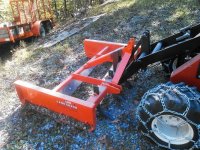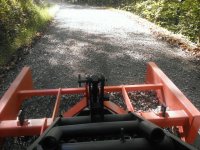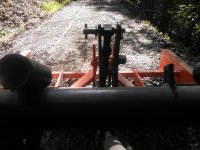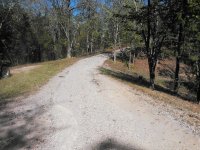KentT
Elite Member
- Joined
- Mar 31, 2005
- Messages
- 2,838
- Location
- Sevierville, TN
- Tractor
- 1993 Power Trac 1430 w/Kubota diesel engine
Got my old PT 1430 back from the welder on Tuesday evening, with the added brackets on the arms for plumbing in the T8 QA system, a couple of custom adapter plates (one for the old PT 3 pin and one for a 2" receiver) and a QA plate added to my new Everything Attachments 5ft Land Shark Land Plane. Though he sprayed primer over his welds, I couldn't wait to spray it with paint (Kubota orange) before trying it out. The T8 QA is not "plumbed" yet -- that begins today -- so I simply used a hammer to tap the locks/dogs and lock it on.
Wow! This works so, so much better than a box blade and is so easy to use. Set it down, level it with the tilt/curl and drag it in float.

I only did about 4 complete passes, backing up and down my driveway, with the "short" side to the outside. Most of my driveway is not designed to have a crown, but to have the full width drain to one side or the other. So, I didn't bother to try to crown it in those areas where a crown would be appropriate.

It slices and fills quickly and the material flows nicely -- even though the driveway was baked hard and packed after the third hottest/driest summer in recorded history.

It is difficult to see, and the debris (leaves and grass) also obscures it, but it brought gravel back to the surface and smoothed it, in areas where it looked like there was no gravel before. I told my wife after using it that it paid for itself the first time I used it. I had gotten an estimate to tail-gate spread 2'-3" of new crusher run at a cost of $1600-1800. Makes this $1000+ investment worthwhile...

FYI. We welded on the QA plate vertical, with a continuous bead top and bottom, to the cross-bar that holds the rippers, flush to the bottom of it. We added a vertical 3/8'x3" vertical bar to each side of the frame for the 3pt toplink, with a continuous weld on each side of them, to the QA plate. This leaves the Cat 1 3pt hitch points fully functional, with the T-8 QA plate simply underneath it, and back out of the way. Using my PT's solid toplink set to the longest length, like I use for bucket work, the range of the tilt/curl work just fine. There was no need to angle it. I think this also reduces the tendency to "climb onto" the attachment when pushing, though I didn't try much of that...
This thing is far, far better than a box blade for this type of work, and much, much easier to use. Set, forget, and drive for the most part. But the 5ft was all my 1430 wanted to pull up my steep driveway, when filled with material. With the QA plate added, it is right at 500lbs plus the weight of the material. I don't know if 4ft ones are available for the 422/425 guys. Even the 1445 guys should stick to a 6ft at most, IMO. With two blades cutting, and the box filled with material, it gives the PT a workout...
Wow! This works so, so much better than a box blade and is so easy to use. Set it down, level it with the tilt/curl and drag it in float.

I only did about 4 complete passes, backing up and down my driveway, with the "short" side to the outside. Most of my driveway is not designed to have a crown, but to have the full width drain to one side or the other. So, I didn't bother to try to crown it in those areas where a crown would be appropriate.

It slices and fills quickly and the material flows nicely -- even though the driveway was baked hard and packed after the third hottest/driest summer in recorded history.

It is difficult to see, and the debris (leaves and grass) also obscures it, but it brought gravel back to the surface and smoothed it, in areas where it looked like there was no gravel before. I told my wife after using it that it paid for itself the first time I used it. I had gotten an estimate to tail-gate spread 2'-3" of new crusher run at a cost of $1600-1800. Makes this $1000+ investment worthwhile...

FYI. We welded on the QA plate vertical, with a continuous bead top and bottom, to the cross-bar that holds the rippers, flush to the bottom of it. We added a vertical 3/8'x3" vertical bar to each side of the frame for the 3pt toplink, with a continuous weld on each side of them, to the QA plate. This leaves the Cat 1 3pt hitch points fully functional, with the T-8 QA plate simply underneath it, and back out of the way. Using my PT's solid toplink set to the longest length, like I use for bucket work, the range of the tilt/curl work just fine. There was no need to angle it. I think this also reduces the tendency to "climb onto" the attachment when pushing, though I didn't try much of that...
This thing is far, far better than a box blade for this type of work, and much, much easier to use. Set, forget, and drive for the most part. But the 5ft was all my 1430 wanted to pull up my steep driveway, when filled with material. With the QA plate added, it is right at 500lbs plus the weight of the material. I don't know if 4ft ones are available for the 422/425 guys. Even the 1445 guys should stick to a 6ft at most, IMO. With two blades cutting, and the box filled with material, it gives the PT a workout...